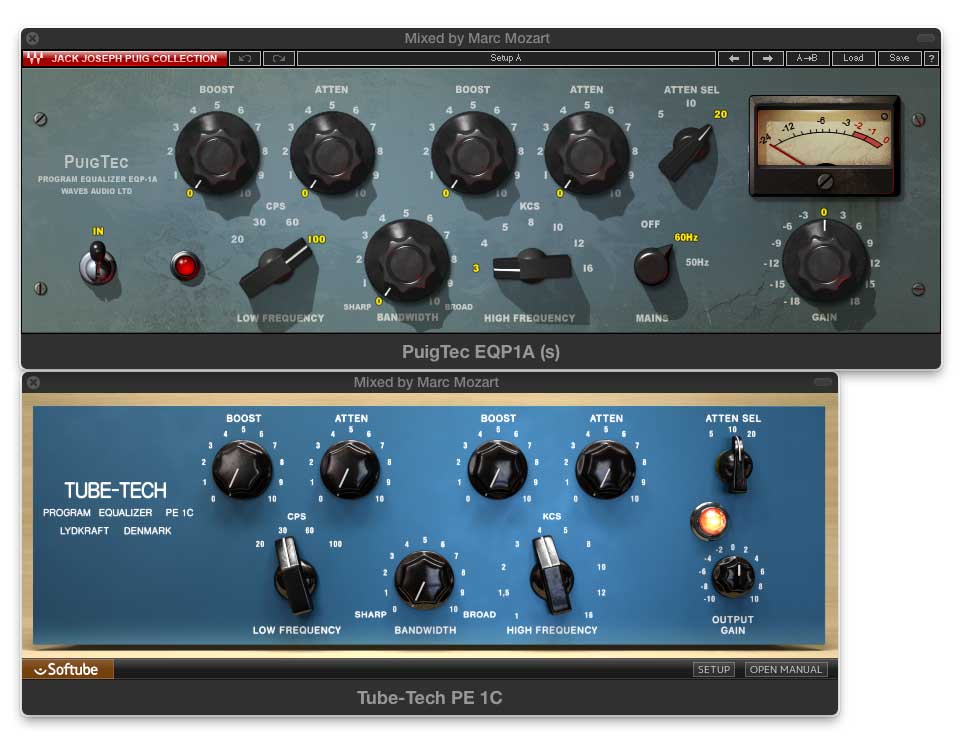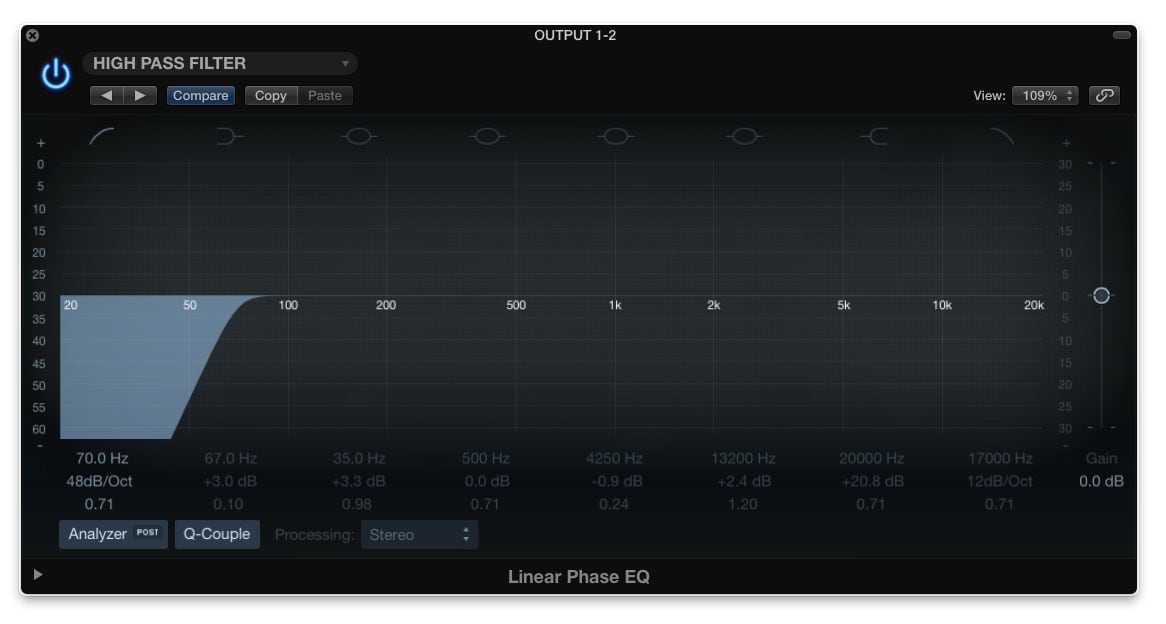This is a look at the most popular classic types of EQs, from my best-selling book “YOUR MIX SUCKS”.
The book is a Complete Mix Methodology for the entire process from DAW preparation to delivery.
Before we dive into specific types of EQs, and where to use them, know that you will need to use a combination of these to cover all your EQ-needs in a mix.
If you are not yet familiar with the classifications explained in this article, take some time to explore the possibilities of these on different sources – I’ll give you some typical examples but don’t limit yourself: on many, if not most of my DAW-channels, I’m using ALL of these EQs at different stages of the plug-in chain.
EQing doesn’t have to be complicated – in the context of setting levels in your mix, EQs can be used in a very basic way.
When you level for example a piano or guitar in the mix, this is as simple as having the upper range of the instruments, including the noise component (piano hammer noises, guitar picking noises) sit right in the mix first, and then use a broad EQ between 200 – 400Hz to adjust the lower range of the instrument by boosting or cutting.
Classic EQ-types

„PULTEC“-TYPE EQS
Probably the EQs I personally use the most in my mixes – the hardware-versions of these are tube-EQs that come in two basic types:
1. the EQP-1 „Program Equalizer“ can boost and reduce bass at the same time (in steps from 20 to 100Hz), and has similar controls plus a bandwidth-parameter for treble (switchable boost for 3, 4, 5, 8, 10, 12, 16kHz, Attenuation/Reduction for 5, 10, 20kHz).

2. the MEQ-1 „Midrange Equalizer“ is an EQ for mids – it has a boost (here called „Peak“) for selectable lower mids (200, 300, 500, 700, 1000Hz), a selectable „DIP“ (reduction) for 200, 300, 500, 700Hz, 1, 1.5, 2, 3, 4, 5, 7kHz and another boost for high mids (switchable between 1.5, 2, 3, 4, 5kHz).

Pultec-type EQs are great for shaping tones in a very natural way. It is difficult to get a bad-sounding result out of them. Even when frequencies are fully boosted, the boost still has a smooth and natural character about it. The reason for this are the Pultecs broad EQ curves. Even when you boost below 100Hz, the boost reaches up to 700Hz. While these EQs have their own character, you can apply EQ-curves similar to them even if you don’t own one. Simply try out broader curves (smaller Q-factors) with the EQ you have at hand.
The EQ-part of the Pultec consists of „passive“ electronics that reduces gain internally, and the tubes are used for a 2 stage line amplifier to make up for the gain lost in the passive EQ-circuit.
There are a couple known variations of these from known manufacturers, and an almost endless number of plug-in versions.
Pultec EQs used to be very exclusive to high-end recording studios, and while the original hardware-versions are still amongst the most expensive EQs you can buy for money, plug-ins are of course a way to use these on pretty much every channel in your mix.
Note that Pultecs add a very desirable and subtle tube saturation to your signal even when the EQ is set flat.

CLASSIC CONSOLE EQs (SSL, NEVE, API)
These are the EQs found on the most popular large format recording consoles from the 1970s until today. You don’t need to own one of these recording consoles as all of these EQs are available as hardware from the original manufacturers, in the popular 500-series format (all three, SSL, AMS Neve and API now offer EQs in the 500-series format, which was an API-invention) and also other formats, like SSL’s “X-Rack”.
Console EQs were designed very flexible, to be able to shape all kinds of signals. They usually have a shelf EQ for the lows and highs, and 1 or 2 bands or fully parametric EQs for the mids (fully parametric meaning including a Q-factor pot that determines the width of the boost or cut). These can often reach as high or low as the low and high shelf EQs.
Today, most people learn about and use them in the form of plug-ins, some of them developed officially with SSL, Neve or API.
I might be a bit simplifying here – but you mainly use these when you want to boost or shape a sound more narrow, or more agressively than what can be achieved with the Pultec-type EQs.
LINEAR PHASE EQs
These are digital EQs, and they were first introduced as super expensive digital outboard boxes for mastering engineers, who have used them for many years. Like everything expensive and digital, it is now available in plug-in form, and for example Logic Pro has a very good linear phase EQ that comes with the software.
There is a ton of technical info on linear phase EQs on the web, none of which will help you improve your mix. One thing they all have in common is adding a signifi- cant latency to your signal that needs to be compen- sated by your DAW. This is a problem when using it on live instrument, but not in mixing. As shown in the chap- ter on parallel compression, just make sure your plugin delay compensation is switched on across all types of audio tracks, and you’ll be fine using it. The reason for the added latency is that instead of „post ringing“ which we see in traditional EQs, the linear phase EQs adds „pre ringing“, which in turn keeps the phase response linear. All you need to know is that the linear phase behaviour makes these sound more neutral and less drastic. They don’t add harmonics and resonances – their effect is to- tally isolated to the frequency range you have selected. They can be used for boosting and attenuating, both broad and narrow.


FILTERS
To list filters here is somehow redundant. Filters always come in the package of most EQs, except the Pultec-type. You use them to remove frequencies below a certain frequency (HPF = High Pass Filter = high frequencies are „allowed“ to pass) or above (LPF = Low Pass Filter = low frequencies are passing).
The most popular application is a HPF on vocals, to remove low rumbling frequency, commonly below 60 – 120 Hz.
So much about the most famous classic types of EQs. I have written a similar post on compressors, one that explains how they can add color to your mix via added harmonics, and another one explaining parallel processing aka parallel compression.
If you found this article helpful, you will like my new book which can guide you through the entire mixing process from DAW preparation to mix delivery. The best-selling eBook YOUR MIX SUCKS is available in English, German, Spanish and french.
[convertkit form=5236308]









